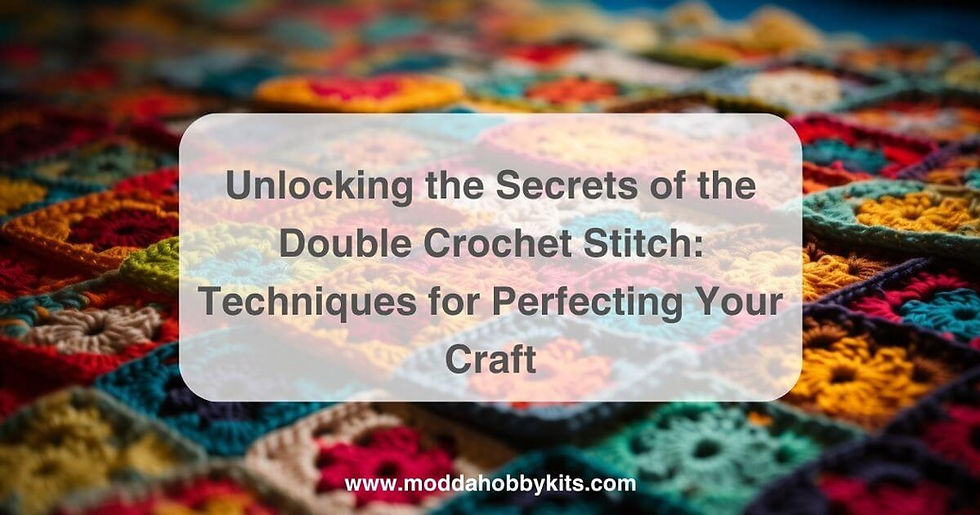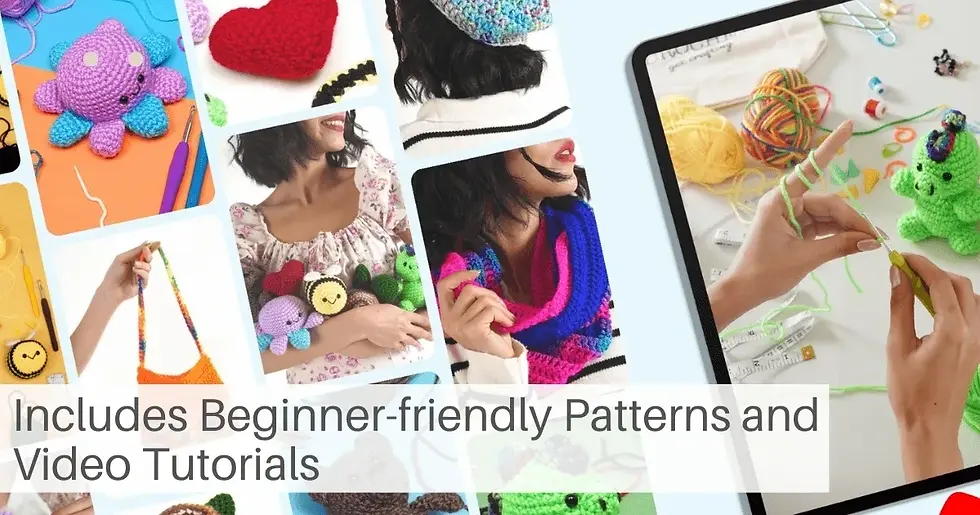
Unravel the mysteries of the double crochet stitch with this comprehensive guide, designed to take your crocheting skills to new heights.
As a versatile and essential component in any crochet project, mastering the double crochet stitch is a must for both beginners and seasoned yarn enthusiasts alike.
Delve into the intricacies of this popular technique—from understanding its unique characteristics to perfecting its execution—and emerge ready to create stunning patterns that showcase your improved craftsmanship.
Key Takeaways
The double crochet stitch is an essential technique in crocheting that can be varied to create unique texture and depth.
Proper tension and gauge are crucial to achieving neat and even stitches, which can be practiced by holding the hook correctly and maintaining consistent pressure on the yarn.
Common mistakes such as uneven tension or incorrect stitch counting can be avoided with careful attention to detail, while more advanced techniques like working in rounds and shaping projects through increasing or decreasing stitches offer endless possibilities for creative expression.
Resources like the Modda Crochet Community provide additional support for perfecting your craft, so keep practicing!
Understanding The Double Crochet Stitch
The double crochet stitch is a fundamental technique in crocheting that involves wrapping the yarn around the hook, inserting it into a stitch, pulling the yarn through, and then completing the stitch by working two loops at a time.
Definition And Basics Of The Stitch
Diving into the world of crochet, one of the fundamental stitches you'll encounter is the double crochet stitch.
Characterized by its versatility and taller height compared to the single crochet stitch, mastering this technique opens up a plethora of creative possibilities in your crocheting journey.
Learning this craft begins with understanding working into a foundation chain – essentially, a series of chains that form the base for your project.
Variations Of The Double Crochet Stitch
There are a few variations of the double crochet stitch that can add some unique texture to your crocheting projects. Here are a few examples:
Back loop only (BLO) double crochet
Instead of inserting your hook into both loops of the stitch, you insert it only into the back loop, creating a ridged effect.
Front loop only (FLO) double crochet
Similar to BLO double crochet, FLO double crochet involves inserting the hook only into the front loop, creating another type of ridge.
Cluster stitch
A cluster stitch is essentially several double crochets worked together. You insert your hook into the designated stitch, yarn over, and pull up a loop, then repeat this process several times before completing all of the double crochets at once.

Double treble (dtr) stitch
This stitch is even taller than a regular double crochet stitch and involves yarning over twice before inserting your hook into the designated stitch.
By incorporating these variations into your crocheting projects, you can create different types of texture and depth.
Importance Of Gauge And Tension
One of the most crucial aspects of crocheting, especially with the double crochet stitch, is achieving the proper gauge and tension.
Gauge refers to the number of stitches per inch in a crocheted piece, while tension describes how tightly or loosely you are holding your yarn and hook.
For example, if you have too few stitches per inch (loose gauge) compared to what's required by the pattern, your finished project will turn out larger than expected.
On the other hand, too many stitches per inch (tight gauge) will result in a smaller end product.
To ensure perfecting your craft with double crochet stitching techniques entails steady practice at different gauges until you’re comfortable producing various sizes with confidence.

Techniques For Perfecting Your Double Crochet Stitch
Learn how to hold your crochet hook properly and achieve neat and even stitches by practicing with the correct tension.
Proper Hook Placement And Holding Techniques
One of the keys to mastering the double crochet stitch is proper hook placement and holding techniques.
Here are some tips on how to do it:
1. Hold your crochet hook like a pencil with your thumb, index, and middle fingers.
2. Position the yarn over your index finger, then under your middle finger and over your ring finger.
3. When inserting the hook into a stitch, make sure it goes through both loops of the V at the top of the stitch.
4. Yarn over by bringing the yarn from back to front over the hook for each stitch.
5. Use your non-dominant hand to hold your work steady and maintain tension in the yarn.
6. Practice keeping a consistent gauge throughout your project by using an appropriately sized crochet hook.
By following these simple techniques, you'll be creating beautiful double crochet stitches in no time!

Tips For Achieving Neat And Even Stitches
Achieving neat and even stitches is essential when it comes to crocheting. Here are some tips for perfecting your double crochet stitch:
Maintain a consistent tension
Consistent tension is crucial to produce even stitches. Make sure that you apply the same amount of pressure to each stitch.
Check your gauge
Checking your gauge before starting a project helps you determine the proper hook size and keeps your stitches uniform throughout the item.
Hold your hook correctly
Holding your hook correctly ensures that the yarn glides smoothly, allowing you to work faster and with precision.
Keep an eye on your loops
Keep an eye on the loops on your hook as they are the foundation of each stitch. Ensure that they are of uniform size and evenly spaced.
Count your stitches
Counting stitches as you go creates an even fabric, especially if working in rows.
Practice, practice, practice
Like any skill, crochet gets better with time and practice. Try making small swatches at first before moving on to larger projects.
By following these tips, you will be able to achieve neat and evenly-spaced double crochet stitches that will make all of your crocheted items look professional and well-crafted!
Counting Stitches And Rows
Counting stitches and rows is a crucial aspect of crocheting, as it ensures that your project turns out the way you intended.
To count individual stitches, simply run your finger along each stitch on the row until you reach the end.
For counting rows, use a tape measure or ruler to measure from the beginning of your work up to the current row.
It's also important to note that some patterns may require specific amounts of stitches or rows for certain sections, so always double-check before moving onto the next step.
Additionally, if you find that you have made an error in your stitch count or lost track of which row you're on, don't panic! Simply unravel back to where things went wrong and try again.
Correcting Common Mistakes
Crocheting is a fun and rewarding hobby, but it can sometimes be frustrating when mistakes happen.
Here are some common mistakes that beginners make when mastering the double crochet stitch, and how to fix them:
Uneven Tension
Sometimes, your tension may vary throughout your project, resulting in uneven stitches. To fix this, practice creating consistent tension by keeping an even grip on your yarn and hook.
Incorrect Stitch Count
Losing track of the number of stitches can cause frustration and errors in your work. Always count your stitches at the end of each row or round to ensure that you maintain the correct count.

Twisted Stitches
When inserting your hook into a stitch, make sure that it goes through both loops of the stitch and not just one. Twisted stitches can cause distortion in your finished piece.
Skipping Stitches
Missing a stitch can throw off the pattern you are following or create holes in your work. Take care to insert your hook into every stitch as directed.
Misreading Instructions
It's important to read and understand each step of a pattern before beginning to crochet. If you're unsure about something, take a moment to review the instructions before proceeding.
By avoiding these common mistakes and utilizing proper techniques for achieving neat and even stitches, you'll be well on your way to mastering the double crochet stitch in no time!

Advancing Your Skills With Double Crochet
Learn how to create texture, work in rounds, and shape your projects by decreasing and increasing with the double crochet stitch.
Mastering these advanced techniques will take your crocheting skills to the next level.
Creating Texture And Depth With Post Stitches
Post stitches, such as the front post double crochet, are great techniques to add texture and depth to crocheted items.
Here are some tips on how to create beautiful textures:
Front Post Double Crochet
This is a popular post-stitch technique that uses the front post of a previous row's stitch to create a raised ridge on the fabric surface.
To make a front post double crochet stitch, insert your hook from the front of your work, around the post of the previous stitch in the row below. Yarn over and pull up a loop, and then complete your double crochet as usual.
Back Post Double Crochet
Similar to front post double crochet, this technique uses the back post of a previous row's stitch instead of the front post.
It creates an indentation rather than a raised ridge on the fabric surface.
Cluster Stitch
Cluster stitches are made by crocheting multiple stitches together into one stitch. This creates a bumpy texture that adds depth and interest to any project.
Bobble Stitch
The bobble stitch is a fun way to add dimension to any project. It involves working several stitches in one spot, creating little "bobbles" on the surface of your work.
Remember that practice makes perfect when it comes to mastering these textured stitches!
Don't be afraid to experiment with different yarns and hooks until you find what works best for you.
By adding texture and depth through post stitches, you can take your crocheting skills to new heights and create stunning pieces that are both beautiful and functional.
Working In Rounds And Combining With Other Stitches
Crocheting in the rounds is a great way to create seamless and continuous projects that do not have a front or back.
You can achieve this by working your crochet stitches in a spiral, instead of joining each row with a slip stitch and starting a new round.
Here are some tips for working in rounds and combining with other stitches:
1. Start with a slip knot and crochet as you normally would, but without joining the first stitch to the last stitch of the previous round.
2. To mark the beginning of each round, use a stitch marker or a piece of contrasting yarn.
3. If you want to add some variety to your project, try incorporating different stitches into your rounds. For example, combine single and double crochet stitches to create interesting textures.
4. Keep count of your stitches so that you maintain the right number for each round.
5. When it's time to increase or decrease your stitches (depending on the pattern), make sure you do so evenly around the work.
6. If you're making something like a hat or bag that requires shaping, increase as necessary until you reach your desired size, then work even rounds until it's time to decrease.
Remember that practice makes perfect when it comes to crocheting in rounds and combining different stitches!
With some patience and persistence, you'll be able to create beautiful projects that showcase your new skills.

Decreasing And Increasing To Shape Your Projects
To create unique and interesting projects with the double crochet stitch, it's important to know how to decrease and increase stitches.
Here are some tips:
1. To decrease stitches, insert your hook into the next stitch, yarn over, and pull up a loop. Then, insert your hook into the following stitch, yarn over, and pull up a loop. Yarn over again and pull through all three loops on your hook.
2. To increase stitches, simply work two double crochets into the same stitch.
3. Increasing and decreasing can help shape your projects in a variety of ways - for example, decreasing at one end of a row can create a tapered edge.
4. When working on a pattern that requires increasing or decreasing, be sure to follow the instructions carefully and keep track of your stitch count.
5. Practice increasing and decreasing on small swatches before applying these techniques to larger projects like blankets or garments.
By mastering these techniques for increasing and decreasing stitches in your crochet work, you'll have even more options when it comes to creating beautiful designs with the versatile double crochet stitch.
Creative Applications Of The Double Crochet Stitch
Discover how to incorporate the versatile double crochet stitch into different patterns, add color and texture, and create complex designs that showcase your creativity.
Incorporating The Double Crochet Stitch Into Different Patterns
The double crochet stitch is a versatile technique that can be used in a variety of patterns to create different textures and designs.
Here are some ways you can incorporate this stitch into your crocheting:
Ribbing
By working rows of double crochet stitches in the back loop only, you can create a ribbed effect that is perfect for cuffs, collars, and hems.
Granny square
The classic granny square is made up of clusters of double crochet stitches worked in the round.
Experiment with different color combinations and arrangements to create unique and colorful designs.
V-stitch
The v-stitch combines sets of double crochet stitches with chain stitches to create an open, lacy fabric that's perfect for shawls, scarves, and wraps.
Ripple/chevron
The ripple or chevron pattern is created by alternating sets of double crochet stitches with decreases (such as skip stitching). This creates a zigzag effect that's great for blankets and afghans.
Texture
Use the double crochet stitch to add texture to your projects by combining it with other techniques such as post stitches, popcorn stitches, or shell stitches.
Remember, learning how to master the double crochet stitch is just the beginning!
Experiment with different patterns and techniques to find what works best for you.
And don't forget that practice makes perfect – the more you work on your crocheting skills, the better you'll become over time!

Using Color And Texture To Enhance The Stitch
Color and texture are essential elements to enhancing the beauty of any double crochet stitch.
Here are some tips on how to make your crocheted items stand out using color and texture:
1. Play with different yarn colors: Choose bright, bold, and contrasting colors to add interest to your projects. Neutrals like black, white, and beige can be combined with other colors for a more subdued effect.
2. Consider the yarn weight: The thicker the yarn, the more texture it will have. Using bulky or super bulky yarn can create a striking textured look while finer yarn is better suited for delicate projects.
3. Experiment with different stitches: Combining double crochets with other stitches like single crochet or half-double stitches creates interesting textures that can elevate your project.
4. Use variegated or self-striping yarn: Variegated or self-striping yarns create a colorful effect without having to change colors in your work.
5. Add embellishments: Embellishing your crocheted item with beads, buttons, sequins or anything you desire can add an extra layer of texture to the finished product.
By incorporating color and texture in your crocheting project, you can take advantage of the versatility of double crochet stitch and create beautiful items that are uniquely yours.
Creating Complex Designs With The Double Crochet Stitch
If you're looking to take your crocheting skills to the next level, mastering the double crochet stitch is a great place to start.
Here are some techniques and tips for creating complex designs using the double crochet stitch:
1. Experiment with color: Double crochet stitches are great for creating colorful patterns. Mix and match different shades of yarn to create a unique design, or try using variegated yarn for a more interesting effect.
2. Combine stitches: The double crochet stitch can be combined with other stitches, such as single crochet or half double crochet, to create intricate patterns. Try alternating between various stitches to create a unique texture.
3. Use post stitches: Post stitches, like the front post double crochet, can be used to add depth and texture to your designs. Experiment with different types of post stitches and see how they can be used in combination with other pattern techniques.
4. Work in rounds: While most people associate crocheting with working in rows, it's possible to work in rounds using the double crochet stitch too. This technique is great for creating seamless designs like hats or bags.
5. Decrease and increase: Once you've mastered the basics of the double crochet stitch, start experimenting with decreasing and increasing stitches to shape your projects.
This will give your designs a more professional look and make them truly one-of-a-kind.
With these tips and techniques, you'll be well on your way to creating beautiful and complex designs using the versatile double crochet stitch!
Conclusion
In conclusion, mastering the double crochet stitch is a fundamental skill for any crocheter.
With proper techniques and practice, you can achieve neat and even stitches to create beautiful projects that showcase your creativity and expertise.
Remember to pay attention to gauge and tension as they are vital in achieving consistent results with your double crochet stitch.
There are endless possibilities when it comes to creating patterns with this versatile stitch, from simple scarves to intricate blankets or garments.
FAQs:
What is the double crochet stitch and how do I execute it properly?
The double crochet stitch is a basic crochet technique that involves wrapping the yarn around your hook, inserting it into the designated stitch, pulling up a loop (3 loops on your hook), wrapping again and pulling through 2 of those loops, then repeating until only one loop remains on your hook. For more detailed instructions or visual aids, there are several online tutorials available.
How can I improve my tension when working with double crochet stitches?
Achieving proper tension in your crocheting projects takes time and practice but some tips to help control yarn tension include holding your yarn at an appropriate distance from the hook while allowing for slight slack in between stitches as well as trying out different hooks sizes to see what feels most comfortable.
Can I use the double crochet stitch for any project or are there limitations?
The double crochet stitch is very versatile and can be used for many types of projects such as blankets, hats, scarves, etc. However, depending upon the desired outcome - other techniques may need to be utilized accordingly; consulting with experienced Crochet artisans could offer additional insight into which techniques will best fit unique needs & desires prior to beginning these endeavors!
How important is gauge when using the double crochet stitch?
Gauge plays an important role in ensuring that finished items meet size requirements especially when pattern specifications must be adhered to closely—whether squareness/symmetry/etc.—to avoid having awkwardly shaped pieces that cannot be assembled correctly later down the line without significant alterations otherwise required by errors early on during construction phase. Therefore, taking extra care to measure gauge accurately based on recommended settings provided will ultimately facilitate success while mastering this specialized art form over time if practiced diligently enough!









Comments